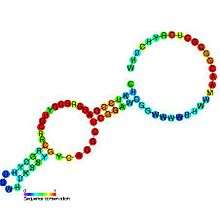SAH riboswitch

| S-adenosyl-L-homocysteine riboswitch | |
|---|---|
 Predicted secondary structure and sequence conservation of SAH_riboswitch | |
| Identifiers | |
| Symbol | SAH_riboswitch |
| Rfam | RF01057 |
| Other data | |
| RNA type | Cis-reg; riboswitch |
| Domain(s) | Bacteria |
| SO | 0005836 |
SAH riboswitches are a kind of riboswitch that bind S-adenosylhomocysteine (SAH).[1] When the coenzyme S-adenosylmethionine (SAM) is used in a methylation reaction, SAH is produced. SAH riboswitches typically up-regulate genes involved in recycling SAH to create more SAM (or the metabolically related methionine). This is particularly relevant to cells, because high levels of SAH can be toxic.[3] Originally identified by bioinformatics,[4] SAH riboswitches are apparent in many species of bacteria, predominantly certain Proteobacteria and Actinobacteria. The atomic-resolution 3-dimensional structure of an SAH riboswitch has been solved using X-ray crystallography.[2]
References
- 1 2 Wang JX, Lee ER, Morales DR, Lim J, Breaker RR (2008). "Riboswitches that Sense S-adenosylhomocysteine and Activate Genes Involved in Coenzyme Recycling". Mol. Cell. 29 (6): 691–702. PMC 2712820
 . PMID 18374645. doi:10.1016/j.molcel.2008.01.012.
. PMID 18374645. doi:10.1016/j.molcel.2008.01.012. - 1 2 Edwards AL, Reyes FE, Héroux A, Batey RT (September 2010). "Structural basis for recognition of S-adenosylhomocysteine by riboswitches". RNA. 16 (11): 2144–2155. PMC 2957054
 . PMID 20864509. doi:10.1261/rna.2341610.
. PMID 20864509. doi:10.1261/rna.2341610. - ↑ Ueland PM (1982). "Pharmacological and biochemical aspects of S-adenosylhomocysteine and S-adenosylhomocysteine hydrolase". Pharmacol. Rev. 34 (3): 223–53. PMID 6760211.
- ↑ Weinberg Z, Barrick JE, Yao Z, et al. (2007). "Identification of 22 candidate structured RNAs in bacteria using the CMfinder comparative genomics pipeline". Nucleic Acids Res. 35 (14): 4809–19. PMC 1950547
 . PMID 17621584. doi:10.1093/nar/gkm487.
. PMID 17621584. doi:10.1093/nar/gkm487.
External links
This article is issued from
Wikipedia.
The text is licensed under Creative Commons - Attribution - Sharealike.
Additional terms may apply for the media files.